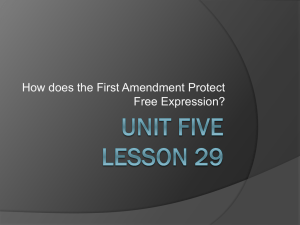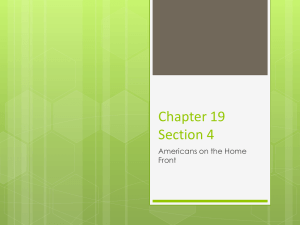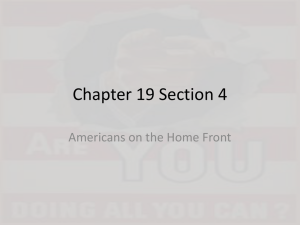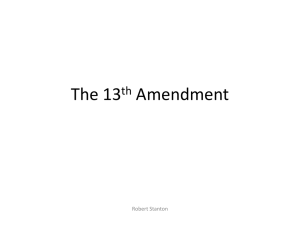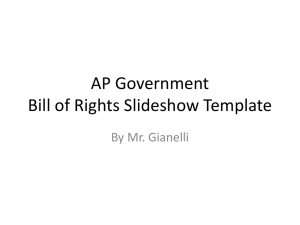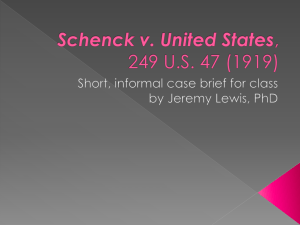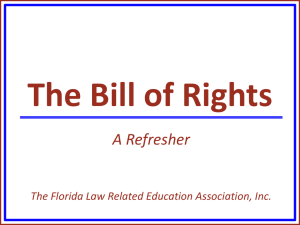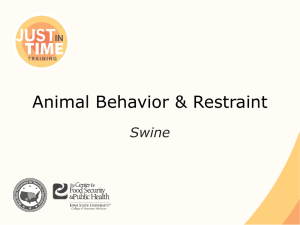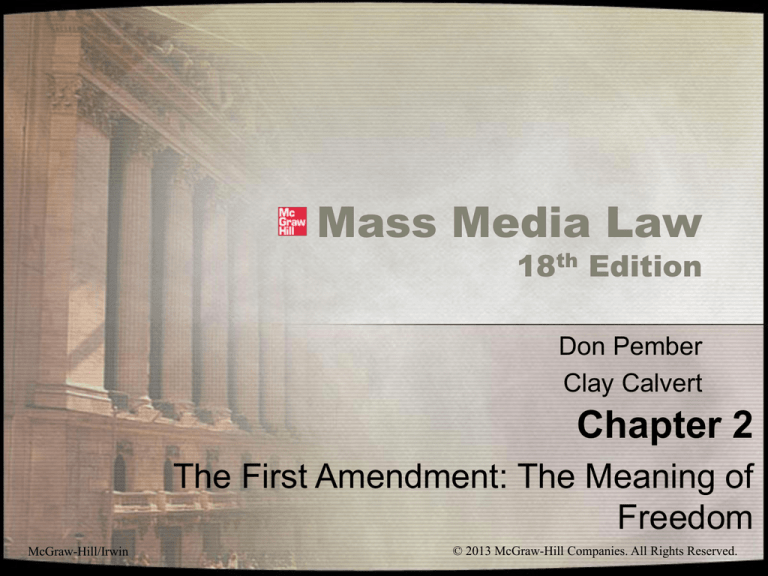
Mass Media Law
18th Edition
Don Pember
Clay Calvert
Chapter 2
The First Amendment: The Meaning of
Freedom
McGraw-Hill/Irwin
© 2013 McGraw-Hill Companies. All Rights Reserved.
Historical Development
Freedom of the Press in England
– The British devised several means to restrict
press:
• Seditious libel laws – punished citizens who
criticized the government
• Licensing/prior restraint laws – required printers
to obtain prior approval from the government or
church before printing
2-2
Historical Development
Freedom of the Press in England
– The British devised several means to restrict
press:
• Bonds – money deposited with the government
that would be forfeited if the government felt
material should not be printed
2-3
Historical Development
Freedom of the Press in Colonial America
– Licensing lasted until the 1720s in the
colonies
– Taxation, though part of the colonial system,
was often ignored by printers
2-4
Historical Development
Freedom of the Press in Colonial America
– Trial of John Peter Zenger
• Zenger was the publisher of the New York
Weekly Journal
• His paper was supported by Lewis Morris
and James Alexander, opponents of the
unpopular colonial governor, William Cosby
2-5
Historical Development
Freedom of the Press in Colonial America
– Trial of John Peter Zenger
• Zenger was jailed in November 1734 after
publishing several articles critical of Cosby
• Although Zenger was clearly guilty under
the seditious libel laws in place at the time,
a jury acquitted him (today called jury
nullification)
2-6
Historical Development
Community Censorship Then and Now
– Proceeding the Revolutionary War
• The content of pro-British newspapers was limited
by community pressure after 1770
• Pro-British printers were attacked, their shops
wrecked, and papers destroyed
2-7
Historical Development
Community Censorship Then and Now
• Contemporary examples:
– Censored episode of “South Park” involving the
Prophet Muhammad
– Removal of art depicting the Prophet
Muhammad from the Islamic collection at New
York’s Metropolitan Museum of Art
2-8
Historical Development
Community Censorship Then and Now
– Heckler’s veto – when a crowd or audience’s
reaction to a speech or message is allowed to
control and silence that speech or message.
2-9
The First Amendment
The New Constitution
– A Bill of Rights was not discussed until very late in the
Constitutional Convention
– Many delegates thought a Bill of Rights was
unnecessary as the state constitutions guaranteed
such rights
– The Bill of Rights was introduced and advocated by
James Madison of Virginia during the First Congress
2-10
The First Amendment
The New Constitution
– The First Amendment to the United States
Constitution:
• Congress shall make no law respecting an
establishment of religion, or prohibiting the free
exercise thereof; or abridging the freedom of
speech, or of the press; or the right of the people
peaceably to assemble, and to petition the
Government for a redress of grievances
2-11
The First Amendment
Freedom of Expression in the 18th Century
– Original Intent – the meaning intended by
the framers of the Constitution
– What did the First Amendment mean in 1791?
• No prior restraint
• No licensing
• No punishment for seditious libel
2-12
The First Amendment
Freedom of Expression in the 18th Century
– Generally, freedom of expression in the late
1700s protected the rights of the speaker
2-13
The First Amendment
• Freedom of Expression Today
– Some scholars argue that freedom of
expression today protects the public’s right to
know -- society’s right to be informed
2-14
The First Amendment
Freedom of Expression Today
– Seven First Amendment Theories
1.
2.
3.
4.
5.
6.
7.
Absolutist theory
Ad hoc balancing theory
Preferred position balancing theory
Meiklejohnian theory
Marketplace of ideas
Access theory
Self-realization
2-15
The First Amendment
Absolutist theory
– “No law” means no law; an absolute
protection against censorship
– Few Supreme Court justices have adopted
this position (Black and Douglas)
2-16
The First Amendment
Ad hoc balancing theory
– When free speech and press rights conflict
with other important rights, courts must
balance these freedoms
– Determined on a case-by-case basis
2-17
The First Amendment
Preferred position balancing theory
– When balancing conflicting rights, speech and
press are preferred – given greater weight –
than other rights
– Today, courts use this theory more often than
any other
2-18
The First Amendment
Meiklejohnian theory
– Public Speech
• Speech or press that advances self-governance
• Should always be protected
– Private Speech
• Speech or press that addresses anything other than
self-governance
• Should not be protected; not essential to selfgovernance
2-19
The First Amendment
Marketplace of ideas
– All information and opinions should be
allowed to compete in a marketplace, with the
best ideas chosen from among the many
– This metaphor, first introduced in the
Supreme Court by Oliver Wendell Holmes, Jr.,
currently dominates the Court’s discussion of
freedom of speech
2-20
The First Amendment
Marketplace of ideas
– Critics of the marketplace of ideas say:
• It allows harmful speech and speech with little
value to be circulated
• Those with the most resources have more and
louder voices in the marketplace of ideas
2-21
The First Amendment
Access theory
– Free speech and press rights are not meaningful to
citizens unless they have access to media outlets
– If media will not voluntarily allow use of airwaves or
print, then government should force this access
– Access theory was struck down in Miami Herald v.
Tornillo by the U.S. Supreme Court
2-22
The First Amendment
Self-Realization/Self-Fulfillment theory
– Speech can be inherently valuable to a person
regardless of its effects on others – it is an end in
itself
– Expressing one’s identity through speech
2-23
The Meaning of Freedom
Seditious Libel and the Right to Criticize the
Government
– The rights to discuss, criticize and oppose the
government is at the center of our political
philosophy today.
2-24
The Meaning of Freedom
Critical Dates in the History of Sedition Law
–
–
–
–
–
–
–
–
–
–
1735
1791
1917
1918
1919
1927
1940
1951
1957
1969
Acquittal of John Peter Zinger
Adoption of First Amendment
Espionage Act
Sedition Act
Clear and present danger test
Brandeis sedition test in Whitney
Smith Act adopted
Smith Act ruled constitutional
Scope of Smith Act narrowed
Brandenburg decreases sedition prosecutions
2-25
The Meaning of Freedom
Alien and Sedition Acts of 1798
– Extended the period prior to naturalization, and gave
the president power to detail and deport non-citizen
residents
– Forbade false, scandalous or malicious publications
against the U.S. government, Congress or the
president
2-26
The Meaning of Freedom
Alien and Sedition Acts of 1798
– John Adams (a Federalist) was president at time law
was passed
– Law aimed at silencing criticism in Jeffersonian
newspapers
– There were 15 prosecutions under the Sedition Act; 8
of those prosecuted were editors of Jeffersonian
newspapers
2-27
The Meaning of Freedom
Alien and Sedition Acts of 1798
– Adams lost his bid for re-election in 1800 in large part
due to his attempts at silencing critics with the
Sedition Act
– The Sedition Act expired in 1801
– Jefferson, now president, pardoned all those who had
been convicted under the Act
2-28
The Meaning of Freedom
Sedition in World War I
– Espionage Act of 1917 made it a crime to:
1. Willfully convey a false report with the intent to
interfere with the war effort
2. Cause insubordination, disloyalty, mutiny or
refusal of duty
3. Willfully obstruct recruiting or enlistment
2-29
The Meaning of Freedom
Sedition in World War I
– Sedition Act of 1918 made it a crime to:
•
cause contempt of or scorn for the federal
government, the Constitution, the flag or the
uniform of the armed services
2-30
The Meaning of Freedom
Sedition in World War I
–
Sedition Act of 1918
•
Under the Act, the U.S. Post Office Department
censored thousands of newspapers, books and
pamphlets
•
Those found to violate the Act, often lost second
class mailing privileges or found their mail was
never delivered
2-31
The Meaning of Freedom
Sedition in World War I
– States also adopted statutes aimed at war
dissenters.
– States passed criminal syndicalism statutes
that forbid the display of a red or black flag
2-32
The Meaning of Freedom
The Smith Act (1940)
– Made it a crime to:
1. Conspire to advocate the violent overthrow of the
government
2. Organize a group that advocated the violent
overthrow of the government
3. Be a member of a group that advocated the
violent overthrow of government
2-33
The Meaning of Freedom
Sedition Today
– In the 1990s, state sedition acts were used to
prosecute those involved with the first World Trade
Center bombing as they “conspir[ed] to overthrow, put
down, or to destroy by force the Government of the
United States.”
– In 2006, a federal judge allowed charges to proceed
under the Espionage Act of 1917 when two former
lobbyists allegedly obtained classified information and
then communicated it.
2-34
Defining the Limits of
Freedom of Expression
The Clear and Present Danger Test
– Holmes in Schenck (1919): “The question in
every case is whether the words used, are
used in such circumstances and are of such a
nature as to create a clear and present
danger that they will bring about the
substantive evils that Congress has a right to
prevent. It is a question of proximity and
degree.”
2-35
Defining the Limits of
Freedom of Expression
The Clear and Present Danger Test
– Brandeis in Whitney (1927): “In order to to
support a finding of clear and present danger
it must be shown either that immediate
serious violence was to be expected or was
advocated, or that the past conduct furnished
reason to believe that such advocacy was
them contemplated.”
2-36
Defining the Limits of
Freedom of Expression
The Clear and Present Danger Test
– Vinson in Dennis (1951):
• Clear and probable danger test
• “In each case [courts] must ask whether the gravity
of the ‘evil’ discounted by its improbability, justifies
such invasion of free speech as is necessary to
avoid the danger.”
2-37
Defining the Limits of
Freedom of Expression
The Clear and Present Danger Test
– Brandenburg v. Ohio (1969):
• The constitutional guarantees of free
speech and free press do not permit a state
to forbid or proscribe advocacy of the use
of force or of law violation except where
such advocacy is directed to inciting or
producing imminent lawless action and is
likely to incite or produce such actions.”
2-38
Defining the Limits of
Freedom of Expression
Real-Life Violence – Blaming Movies, Video
Games and Books
– The Brandenburg test for incitement to violence has
also been used in wrongful death, negligence and
product liability suits arising from the use of media
products
2-39
Defining the Limits of
Free Expression
Real-Life Violence – Blaming Movies, Video
Games and Books
– Media products that have been challenged in court
include:
• Movies: The Basketball Diaries
• Video Games: Grand Theft Auto, Mortal Kombat, Resident
Evil
• Books: Hit Man
2-40
Defining the Limits of
Free Expression
Real-Life Violence – Blaming Movies, Video Games and
Books
–
To justify regulations based on content, the strict scrutiny
standard of judicial review must be satisfied.
–
Under strict scrutiny, the state must prove:
1.
It has a compelling interest of the highest order to regulate the
content, and
2.
The regulation restricts no more speech than necessary to
advance that interest
2-41
Defining the Limits of
Freedom of Expression
The Gitlow Ruling and the Incorporation
Doctrine
–In Gitlow v. New York, the U.S. Supreme
Court established the incorporation doctrine
– the free speech and free press clauses of the
First Amendment are “incorporated” through the
14th Amendment due process clause as
fundamental liberties that apply to all levels of
government
2-42
Prior Restraint
Near v. Minnesota (1931)
– Jay M. Near, publisher of the Saturday Press
published articles that attacked city corruption and
government officials
– A Minnesota statute empowered courts to declare a
newspaper a public nuisance
– The Saturday Press was declared public nuisance,
and was enjoined from printing any further editions
2-43
Prior Restraint
Near v. Minnesota (1931)
– The U.S. Supreme Court ruled the Minnesota statute
was an unconstitutional prior restraint on free press
– The Court also ruled that prior restraint is
unconstitutional except in extreme situations, and the
government carries the burden of proof to prove
validity of exceptions
2-44
Prior Restraint
The Pentagon Papers (1971)
– The Supreme Court ruled the New York Times and
Washington Post could publish historical documents
that lead the U.S. intervention in the Vietnam conflict
– The Court here did not say the Times and Post had a
First Amendment right to print this story, just that the
government failed to make a strong enough case for
prior restraint
2-45
Prior Restraint
U.S. v. Progressive (1979)
– A reporter gathered information from unclassified
sources on how to build an H-Bomb to run in the April
1979 issue of Progressive magazine
– The U.S. government found out about publication
before release of magazine, and asked courts for a
permanent injunction against publication
2-46
Prior Restraint
U.S. v. Progressive (1979)
– The U.S. District Court ruled Progressive magazine
could be enjoined from publishing the article as specific
details were not necessary to carry out an informed
debate on nuclear issues
– Progressive appealed its case, but before an appellate
court could hear the case, a Wisconsin newspaper ran
the same story, and the government withdrew its case,
leaving the case with little precedential value
2-47
Prior Restraint
U.S. v. Bell (2005)
– A federal appellate court upheld a permanent
injunction barring Thurston Paul Bell from promoting
and selling unlawful tax advice on his website
– Ruled that the usually heavy presumption against
prior restraint here “does not apply to restriction on
unprotected speech, including false or unlawful
commercial speech”
2-48

